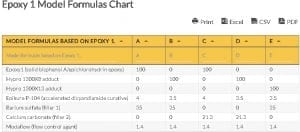Epoxy 1 Model Formulas Chart
 The Epoxy 1 Model Formulas Chart shows the coating compositions and formulation categories based on epoxy resins. The table is useful for determining the correct powder coatings and their respective formulations or parts per weight.
The Epoxy 1 Model Formulas Chart shows the coating compositions and formulation categories based on epoxy resins. The table is useful for determining the correct powder coatings and their respective formulations or parts per weight.
Epoxy 1 Model Formulas Table Analysis
The Table for Epoxy 1 Model Formulas shows the weight percentage per sample as shown in letters. Each letter in the column represents the formulations or model formulas, and the parts per weight. For instance, Formula A has 100 parts per Epoxy 1 modified with Epikure P-104, Barium sulfate (filler 1), unmodified with Calcium carbonate (filler 2), and modified with Modaflow (flow control agent). The same formulation applies to the other columns.
The Epoxy 1 Model Formulas and Table shows that adducts, fillers, and additives can improve or affect the epoxy powder coating’s flexibility, resistance, performance, and durability.
Epoxy 1 Model Formulas Chart
| Model formulas based on Epoxy 1. | A | B | C | D | E | |
|---|---|---|---|---|---|---|
| wdt_ID | Model formulas based on Epoxy 1. | A | B | C | D | E |
| 1 | Epoxy1 (solid bisphenol A/epichlorohydrin epoxy) | 100 | 0 | 100 | 0 | 0 |
| 2 | Hypro 1300X8 adduct | 0 | 100 | 0 | 100 | 0 |
| 3 | Hypro 1300X13 adduct | 0 | 0 | 0 | 0 | 100 |
| 4 | Epikure P-104 (accelerated dicyandiamide curative) | 4 | 3.5 | 4 | 3.5 | 3.5 |
| 5 | Barium sulfate (filler 1) | 35 | 35 | 0 | 0 | 35 |
| 6 | Calcium carbonate (filler 2) | 0 | 0 | 21.3 | 21.3 | 0 |
| 7 | Modaflow (flow control agent) | 1.4 | 1.4 | 1.4 | 1.4 | 1.4 |
Epoxy 1 Model Formulas Chart
| Model formulas based on Epoxy 1. | A | B | C | D | E | |
|---|---|---|---|---|---|---|
| wdt_ID | Model formulas based on Epoxy 1. | A | B | C | D | E |
| 1 | Epoxy1 (solid bisphenol A/epichlorohydrin epoxy) | 100 | 0 | 100 | 0 | 0 |
| 2 | Hypro 1300X8 adduct | 0 | 100 | 0 | 100 | 0 |
| 3 | Hypro 1300X13 adduct | 0 | 0 | 0 | 0 | 100 |
| 4 | Epikure P-104 (accelerated dicyandiamide curative) | 4 | 3.5 | 4 | 3.5 | 3.5 |
| 5 | Barium sulfate (filler 1) | 35 | 35 | 0 | 0 | 35 |
| 6 | Calcium carbonate (filler 2) | 0 | 0 | 21.3 | 21.3 | 0 |
| 7 | Modaflow (flow control agent) | 1.4 | 1.4 | 1.4 | 1.4 | 1.4 |
Legend:
A, B, C, D, E – represent the various model formulas
Epoxy 1 Model Formulas Chart: Definition of Terms
Epoxy
Epoxy consists of a hardener and an epoxy resin that, when mixed together in a proper formulation or combo, will produce a hard, solvent, and chemical-resistant finish. Epoxies are used in pipes, stones, metals, woods, and painted and veneer surfaces.
Filler
Filler is an epoxy used to thicken the primer epoxy, fill dings and gaps, and smooth or level surfaces.
Flow Control
Flow control Is an epoxy agent used to ensure the proper spreading of the epoxy onto the surface without any fish eye, cratering, or surface defect.
Powder Coatings
Powder coating is an adhesive applied through the electrostatic spray deposition or ESD. The powder can be a thermoset or thermoplastic polymer (a plastic material).
The following are the various types of powder coatings:
Solid Bisphenol A
This is an organic compound that is crystalline and a colorless solid. The material is often used in containers, epoxy resins, adhesive coatings, and electrical insulation.
Epichlorohydrin Epoxy
This Is a pungent, sweet, and colorless liquid used for making epoxy resins.
Hypro 1300X8 Adduct
This is an acrylonitrile copolymer – carboxyl terminated butadiene—that is used as a reactant to improve epoxy performance. Adduct means the result of addition reaction.
Hypro 1300X13 Adduct
This is a carboxyl terminated butadiene or CTBN epoxy toughener. It is used as a reactant with a base.
Epikure P-104 (Accelerated Dicyandiamide Curative)
This is a trademark that refers to a curing agent and powder epoxy curing agent.
Barium Sulfate (Filler 1)
This is a transparent inorganic compound that is used to change consistency or can become a filler. Barium sulfate is also used as pigment.
Calcium Carbonate (Filler 2)
This is a filler and pigment. It has the largest volume filler that is often used in plastic applications.
Modaflow (Flow Control Agent)
This is an additive used without adding silicone. It’s used for latex, water-reducible, and dispersion systems.
Go here if you are looking for the Coating Thickness Conversion Chart.


